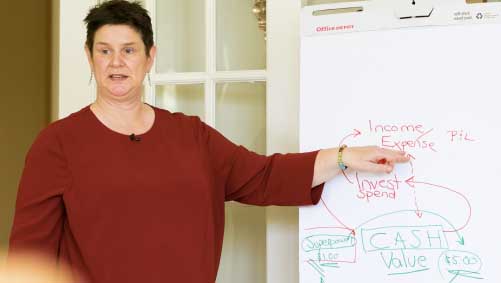
Bitcoin Halving and Its Impact on Entrepreneurs
By now, you’ve probably heard the buzz about the upcoming Bitcoin halving.
And you’re probably in one of three camps:
1: “Am I supposed to know what ANY of those words mean?”
2: “Yeah I’ve heard about it, but what’s the big deal?”
3: “Way ahead of you, Pam. I’ve been watching the news for weeks.”
If you’re a small business owner or an entrepreneur aiming to hit the big leagues, knowing about Bitcoin and cryptocurrency can give you that financial edge you need to stay ahead of the game.
Today we’re jumping headfirst into Bitcoin and halving, and I’m going to break it down for you in simple terms (because this shit can be incredibly confusing, and I’m still learning more about it every day).
The Basics of Bitcoin Halving
First off, to really get why halving matters, you need to know some basic definitions of Bitcoin mining:
1. Blocks and Blockchain
Let’s explain what “Bitcoin halving” actually means – it’s when the reward for acquiring new Bitcoin is slashed in half.
As Bitcoin transactions are added, every so many of them get grouped into what’s called a potential block. A potential block is a single block of data that might have 30, 40, or 100 transactions in it.
At the end of every block there is a code that’s the same as at the beginning of the next block. These blocks are linked together to form a blockchain.
The blockchain is a distributed database maintained across computers that are linked in a peer-to-peer (P2P) network. Linking blocks into a blockchain creates a hash, which is a digital fingerprint that self-verifies if it has been tampered with (making it super secure). And that process of linking potential blocks is what miners are aiming for.
2. Miners and Rewards
When a potential block is ‘mined,’ it’s mined by somebody called a miner, someone who is trying to ‘solve’ the block.
To put it simply, when a miner uses cryptography to solve the block, it means that their powerful computer randomly generates many options to solve tough math problems to find the hash, or the answer. One of them wins, creating the code that joins that block to the next, and adding it to the blockchain.
Miners put a lot of money into the equipment and the computers that allow us to solve for the blocks, and for this, they get Bitcoin as a reward. This process is called minting.
3. Halving
Halving ensures Bitcoin’s supply grows at a predictable rate, with a max of 21 million Bitcoins; this scarcity is key to its value. Halving happens every time an additional 210,000 blocks are added to the blockchain – typically about every four years.
Initially, the first miners earned 50 Bitcoins per block. After each halving, the reward is cut in half, now standing at 3.125 Bitcoins.
Considering the most recent halving this past April, here’s a quick look at past halvings:
2012: Bitcoin jumped from $12 to $135 in 300 days.
2016: It shot up from $658 to $1,551 in 300 days.
2020: It soared from $8,601 to $50,941 in 300 days.
And now, in 2024, with Bitcoin hovering around $65,000, everyone’s guessing:
Will it skyrocket to $350,000, or have we seen its peak?
Since the price increased five times its value last time, is it going to go five times this time? (Personally, I think that might be a little overkill)
Has Bitcoin run its course? Is it over?
Is it staying at $65,000, forcing miners to drop off due to lack of funds to cover equipment costs?
But while the future is anyone’s guess, knowing past trends helps you make smart moves.
“Playing on the blockchain is like playing in the Wild West,” as my friends at Bankless Podcast say.
Why Bitcoin Halving Matters to You
As a small business owner (especially if you’re in camp 1 or 2 from above), you might be asking, “Why should I care?”
Well, here’s why:
Bitcoin is unlike any other currency we have in the world.
It’s not like gold, where you could potentially dig somewhere and find more gold.
And it’s not like the US dollar, where we could just print more money or charge more interest.
With Bitcoin, it’s a contained universe, and it’s only ever going to have 21 million Bitcoin. When that last block is mined, there are no more; it’s automatically rare.
That sense of scarcity will always continue to drive this price and maintain high demand. And once the demand is high? That’s going to drive price even more, because nobody knows when and if they’re ever gonna get in on it. The only thing we can do at that point is trade this stuff!
And that’s why, as a small business owner, staying informed about these trends in cryptocurrency can help you tap into emerging opportunities and get ahead of the game.
Where to Start Your Bitcoin Journey
Trust me: you want to stay informed on Bitcoin, folks.
I STRONGLY recommend you work with your financial advisors to develop a solid investment strategy that aligns with your business goals, especially if you’re new to crypto.
Keep up with news and updates on Bitcoin, and seriously consider putting some of your investment portfolio into cryptocurrencies—because as we know, diversification can help reduce risks and boost potential returns.
But, for me, the number one way to learn about this stuff is to engage with Bitcoin and crypto communities online to share knowledge and stay updated on industry trends.
(If you have interest in learning more about bitcoin and cryptocurrency and looking for a group to talk about it, check out Bitcoin for Traditionals or drop a comment below.
There is a very easy way to step into this world without it being overwhelming. We’ll give you small, daily action items to get further invested or involved in the crypto world, as far as you want to. We’ll tell you what you need to know.)
Join the massive crypto contingent on Discord, with groups ranging from beginners to crypto pros.
Listen to podcasts (I highly recommend Bankless – it’s what inspired me to go down the crypto rabbit hole), read articles, and browse through YouTube content for education, news, and advice.
For more on Bitcoin and cryptocurrency, check out S4E8 of The Cashflow Podcast on YouTube, Apple Podcasts, or Spotify.

Author, Virtual CFO, and Finance Coach
“Your First CFO: The Accounting Cure for Small Business Owners” on AMAZON
“Founder to Exit: A CFO’s Blueprint for Small Business Owners” on AMAZON
***Disclaimer: This is not to be taken as legal advice. Seeking guidance from investing professionals and financial advisors is essential; these professionals can help you understand your options and make informed decisions based on your unique needs and circumstances.





